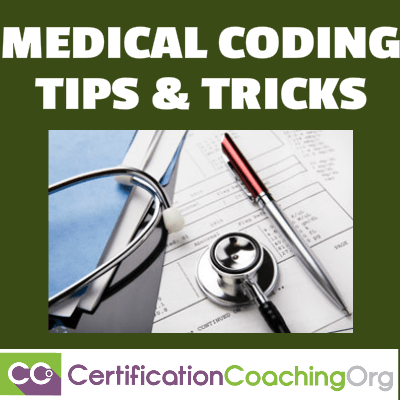You’ll find these medical coding tips helpful because they come from seasoned medical coders and billers and will keep you sane when you’re knee-deep in coding.
Here are 7 Medical Coding Tips and Tricks for Beginners:
1. Verify patient benefits
To avoid unpleasant “Gotcha!” moments, call the payer to check for remaining deductibles, co-insurance responsibilities, and any applicable copayments, and collect them prior to admission from the patient. Also verify the need for a prior authorization for any planned procedures. Source: http://www.dummies.com/how-to/content/tips-from-billing-and-coding-pros.html
Related Article: 10 Medical Coding Tips To Land Your First Medical Coder Job
2. Get vital patient info at check-in
Collect patient demographics and get a copy of the insurance card upon patient arrival. You need this information when the time comes to code and submit the claim.
Also verify patient identification. If your office doesn’t have one already, institute a policy that all patients must present a government-issued ID upon arrival; then make a copy and place in the record. Source: http://www.dummies.com/how-to/content/tips-from-billing-and-coding-pros.html
Medical Coding Tips: Time Management & CPT Coding Changes — VIDEO

3. Review the documentation ASAP
Although you technically have a few days before you must code and send the claim off, don’t delay. Your goal should be to have the claim out the door within 72 hours. Review the medical documentation as soon as possible after the encounter to see whether it is as complete as you need it to be. If you find any omissions or ambiguities, query the physician as soon as possible. Source: http://www.dummies.com/how-to/content/tips-from-billing-and-coding-pros.html
Related Article: Medical Coding Job Interview Tips
4. Take an Inventory of Your Training Materials
Take an inventory of your current training materials, how you resolve coder questions, physician queries, and how you get documentation for incomplete charts. Evaluate this information to ensure these same processes can be followed remotely. It’s important that your remote coders resolve problems with a chart as efficiently as an on-site coder. Therefore, remote coders must have access to the same people and resources as an in-house coder. Source: http://blog.evrichart.com/blog/4-tips-for-a-smooth-transition-to-remote-medical-coding
5. Use “Incident to” coding only with Medicare.
This elementary rule can make a big difference in how practices use their nonphysician practitioners, says Melanie Witt, a coding educator from Fredericksburg, VA. Medicare’s “incident to” rule requires that a physician be present in the office suite when a nonphysician practitioner is treating patients. The rule also stipulates that the supervising physician must initiate the treatment, so the NP or PA cannot see new patients.
However, private payers have their own rules, Witt cautions. Many allow nonphysician practitioners to treat new patients, and some even allow them to be the supervising provider in the office. Knowing each carrier’s rules for nonphysician practitioner billing can prevent having to repay claims after an audit if the rules aren’t followed, she notes. Source: http://medicaleconomics.modernmedicine.com/medical-economics/content/coding-consult-six-top-coding-tips
Related Article: Medical Coding Tips — 4 Ways To Code Delivering A Baby
6. Choose the E&M and ICD-9-CM codes yourself.
Coders shouldn’t have to figure out your intent or guess what care you rendered and what diagnoses determined the need for the service, according to Eskew. A coder or other staff member might easily downcode or upcode E&M visits, resulting in lost revenue or skewed statistics of higher-level visits. Source: http://medicaleconomics.modernmedicine.com/medical-economics/content/coding-consult-six-top-coding-tips
7. Be Mindful of Varied Data Uses
For consistent data, it is important for everyone to follow the same coding rules and conventions when assigning codes. Adherence to applicable coding guidelines, conventions, and instructions is absolutely necessary. Coding professionals need to keep in mind that the coded data is not only collected and used for current needs, but also stored for future use. Both current and future users of this coded data rely on the data being reported with adherence to official coding guidelines, coding rules, and conventions.
Applicable data set definitions must also be followed. For example, when reporting diagnosis and procedure codes for inpatient and all non-outpatient settings, coders must follow the Uniform Hospital Discharge Data Set (UHDDS) definitions of principal diagnosis, other diagnoses, principal procedure, and significant procedures. Source: http://library.ahima.org/xpedio/groups/public/documents/ahima/bok1_050222.hcsp?dDocName=bok1_050222
Related Article: 6 Tips — Making The Most of Your Medical Coding Career — Video
Check out our FREE Medical Coding Guides and Tools

![[CCO] Certification Coaching Organization LLC [CCO] Certification Coaching Organization LLC](https://www.cco.us/wp-content/uploads/2015/05/CCO-Logo-2015-d3-500px.png)
I really like your tips and tricks for medical coding. These are really helpful for those who wants to start their career in healthcare. Medical coding is the transformation of healthcare diagnosis, procedures, medical services, and equipment into universal medical alphanumeric codes. The diagnoses and procedure codes are taken from medical record documentation, such as transcription of physician’s notes, laboratory and radiologic results, etc. Here i want to share 4 more tips to become a better medical biller or medical coder: Don’t hesitate to ask questions, Study existing records, Avoid errors and missed items, Be efficient in the use of your time.